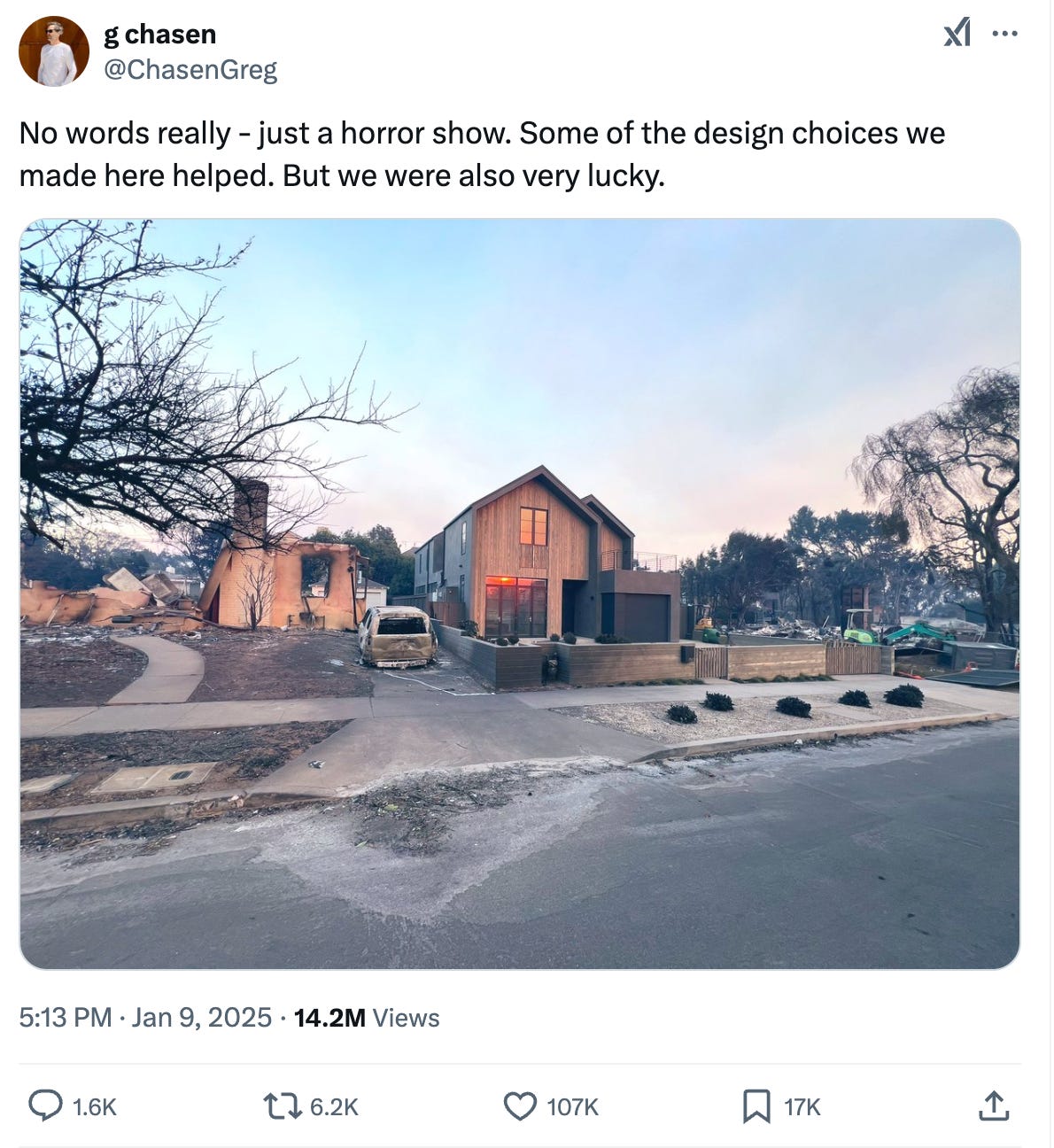Building Code is the New Zoning Reform
Codes need updating not only for climate threats, but for affordability
After the first days of the Palisades wildfire in Los Angeles, a photo of a house that was not destroyed quickly went viral.
In a piece for CityLab, Kriston Capps interviewed Chasen about which design choices, exactly, helped this home escape complete destruction:
The yard is a protected area free of vegetation, fenced off by cast-in-place concrete garden walls, with landscaping in a sparse Mediterranean desert style. The home’s owner has been through fires before, so he was prepared: He removed trash cans and other loose items from around the house and even left the side gates open, knowing that a fire can spread along a fence to a house….
Other design factors are more subtle. Along the side of the house there are no eaves or overhangs, which can form eddies or trap embers blown by high winds. The house doesn’t have any attic vents to allow sparks to get inside the roof, which is metal, with a fire-resistant underlayment. And the house is simple: front-gabled without multiple roof lines, dormers or other pop-outs, which are vulnerable intersections in a fire.
Still other elements are invisible — yet critical. The walls of the house have a one-hour fire rating. The deck is Class A wood, as resistant to ignition as concrete or steel, Chasen says. Tempered glass protects the interiors. And the front of the house was built with heat-treated wood, shielded from flying sparks and embers by the extruding walls and roof line.
Many other pundits and publications have agreed: these ways of “hardening” a home help them survive wildfires. But fire jumps from house to house, so it’s important that not just one single home take these preventative measures. As the LA Times notes: “Unless everyone takes the same approach to hardening their property, there’s no hope of avoiding a future disaster.”
People have been calling the wildfires the “Hurricane Katrina moment” for Los Angeles. But the better analogy may be Hurricane Andrew, which sparked a major transformation of Florida’s building code.
This is a crisis we should not waste: a push for rethinking building code is long overdue. Updating building codes will not only help us to defend people and property from climate change, but also help to address the housing affordability crisis, and the mismatch between our housing stock and contemporary American lifestyles.
Stronger Building Code is Critical for the Coming Decades
There’s been a lot of discussion about whether we should allow people to rebuild in the areas decimated by wildfires this month. Nearly 30 years ago, Mike Davis wrote that Malibu shouldn’t be rebuilt.
At least once a decade a blaze in the chaparral grows into a terrifying firestorm consuming hundreds of homes in an inexorable advance across the mountains to the sea. Since 1970 five such holocausts have destroyed more than one thousand luxury residences and inflicted more than $1 billion in property damage. Some unhappy homeowners have been burnt out twice in a generation, and there are individual patches of coastline or mountain, especially between Point Dume and Tuna Canyon, that have been incinerated as many as eight times since 1930.
You would think that we would have learned by now to not build in these places.
And yet, disaster after disaster, whether wildfire or hurricane, we’ve rebuilt most of the areas that were once in ruins. Two years after Paradise, California was incinerated, the town broke records for construction and was California’s fastest-growing area.
If we are committed to building in harm’s way — and I think we are, since the area in harm’s way is expanding each year — we have to do it better.
Florida shows how this can be done. Prior to Hurricane Andrew, Florida had some 400 different building codes. Two years afterward, all of South Florida adopted one unified building code which raised requirements for defending a building against hurricane-strength winds. In 2002, Florida adopted this code statewide.
As has been widely reported, homes that are built or retrofitted to Florida Building Code standards are withstanding hurricanes with limited damage. Meanwhile, any building that was last up to code prior to the Florida Building Code adoption in 2002 is likely to get serious damage in a hurricane. The photos below illustrate the difference in damage to buildings constructed pre- and post-code in St. James City, Florida, following Hurricane Ian in 2022.


So why isn’t California updating its building code? While California has updated code in rural areas, the state has underestimated the likelihood of urban wildfires. It’s also been stymied by homeowners who seemingly underestimate their own risk of losing their property in a wildfire.
An NPR piece notes:
In 2020, state lawmakers passed a bill to create an "ember-resistant zone" within five feet of a house, which is known as "Zone 0." State fire officials are still drafting the rules, which are expected to severely limit or eliminate all vegetation next to a house for the first time.
Fire officials have already heard strong pushback from the public, since many homeowners have established greenery outside their windows they don't want to part with. After several years of delay, the rules are not yet in effect for existing homes and are expected to begin in 2026.
Building Code is More than Climate Resilience
But now that the wildfires have gotten people’s attention, it might be easier to push for swifter, fuller updates to the building code and to beat back resistance. And it might be a moment for homeowners to more willingly harden their homes, particularly if local governments — or insurers — provide incentive.



